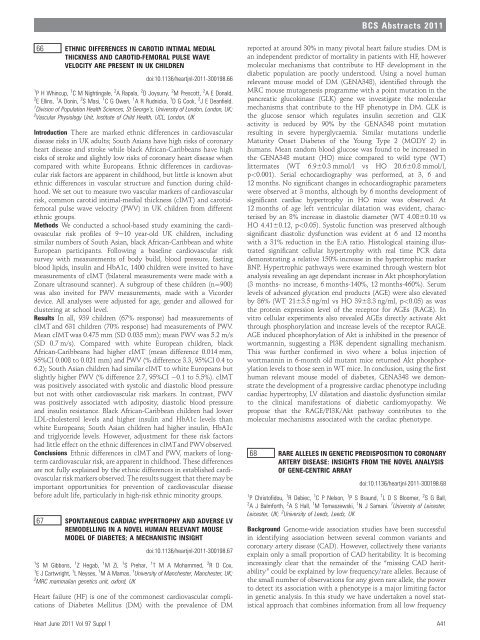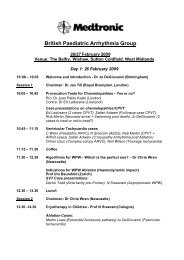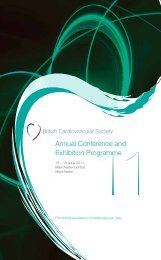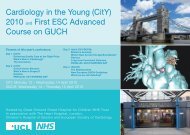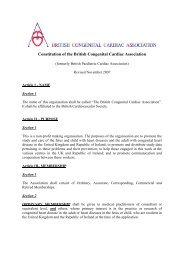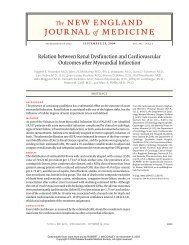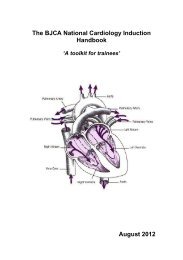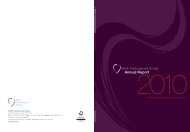Full Supplement - British Cardiovascular Society
Full Supplement - British Cardiovascular Society
Full Supplement - British Cardiovascular Society
Create successful ePaper yourself
Turn your PDF publications into a flip-book with our unique Google optimized e-Paper software.
BCS Abstracts 2011<br />
66 ETHNIC DIFFERENCES IN CAROTID INTIMAL MEDIAL<br />
THICKNESS AND CAROTID-FEMORAL PULSE WAVE<br />
VELOCITY ARE PRESENT IN UK CHILDREN<br />
doi:10.1136/heartjnl-2011-300198.66<br />
1 P H Whincup, 1 C M Nightingale, 2 A Rapala, 2 D Joysurry, 2 M Prescott, 2 A E Donald,<br />
2 E Ellins, 1 A Donin, 2 S Masi, 1 C G Owen, 1 A R Rudnicka, 1 D G Cook, 2 J E Deanfield.<br />
1 Division of Population Health Sciences, St George’s, University of London, London, UK;<br />
2 Vascular Physiology Unit, Institute of Child Health, UCL, London, UK<br />
Introduction There are marked ethnic differences in cardiovascular<br />
disease risks in UK adults; South Asians have high risks of coronary<br />
heart disease and stroke while black African-Caribbeans have high<br />
risks of stroke and slightly low risks of coronary heart disease when<br />
compared with white Europeans. Ethnic differences in cardiovascular<br />
risk factors are apparent in childhood, but little is known abut<br />
ethnic differences in vascular structure and function during childhood.<br />
We set out to measure two vascular markers of cardiovascular<br />
risk, common carotid intimal-medial thickness (cIMT) and carotidfemoral<br />
pulse wave velocity (PWV) in UK children from different<br />
ethnic groups.<br />
Methods We conducted a school-based study examining the cardiovascular<br />
risk profiles of 9e10 year-old UK children, including<br />
similar numbers of South Asian, black African-Caribbean and white<br />
European participants. Following a baseline cardiovascular risk<br />
survey with measurements of body build, blood pressure, fasting<br />
blood lipids, insulin and HbA1c, 1400 children were invited to have<br />
measurements of cIMT (bilateral measurements were made with a<br />
Zonare ultrasound scanner). A subgroup of these children (n¼900)<br />
was also invited for PWV measurements, made with a Vicorder<br />
device. All analyses were adjusted for age, gender and allowed for<br />
clustering at school level.<br />
Results In all, 939 children (67% response) had measurements of<br />
cIMT and 631 children (70% response) had measurements of PWV.<br />
Mean cIMTwas 0.475 mm (SD 0.035 mm); mean PWV was 5.2 m/s<br />
(SD 0.7 m/s). Compared with white European children, black<br />
African-Caribbeans had higher cIMT (mean difference 0.014 mm,<br />
95%CI 0.008 to 0.021 mm) and PWV (% difference 3.3, 95%CI 0.4 to<br />
6.2); South Asian children had similar cIMT to white Europeans but<br />
slightly higher PWV (% difference 2.7, 95%CI 0.1 to 5.5%). cIMT<br />
was positively associated with systolic and diastolic blood pressure<br />
but not with other cardiovascular risk markers. In contrast, PWV<br />
was positively associated with adiposity, diastolic blood pressure<br />
and insulin resistance. Black African-Caribbean children had lower<br />
LDL-cholesterol levels and higher insulin and HbA1c levels than<br />
white Europeans; South Asian children had higher insulin, HbA1c<br />
and triglyceride levels. However, adjustment for these risk factors<br />
had little effect on the ethnic differences in cIMTand PWVobserved.<br />
Conclusions Ethnic differences in cIMT and PWV, markers of longterm<br />
cardiovascular risk, are apparent in childhood. These differences<br />
are not fully explained by the ethnic differences in established cardiovascular<br />
risk markers observed. The results suggest that there may be<br />
important opportunities for prevention of cardiovascular disease<br />
before adult life, particularly in high-risk ethnic minority groups.<br />
67 SPONTANEOUS CARDIAC HYPERTROPHY AND ADVERSE LV<br />
REMODELLING IN A NOVEL HUMAN RELEVANT MOUSE<br />
MODEL OF DIABETES; A MECHANISTIC INSIGHT<br />
doi:10.1136/heartjnl-2011-300198.67<br />
1 S M Gibbons,<br />
1 Z Hegab,<br />
1 M Zi,<br />
1 S Prehar,<br />
1 T M A Mohammed,<br />
2 R D Cox,<br />
1 E J Cartwright, 1 L Neyses, 1 M A Mamas. 1 University of Manchester, Manchester, UK;<br />
2 MRC mammalian genetics unit, oxford, UK<br />
Heart failure (HF) is one of the commonest cardiovascular complications<br />
of Diabetes Mellitus (DM) with the prevalence of DM<br />
Heart June 2011 Vol 97 Suppl 1<br />
reported at around 30% in many pivotal heart failure studies. DM is<br />
an independent predictor of mortality in patients with HF, however<br />
molecular mechanisms that contribute to HF development in the<br />
diabetic population are poorly understood. Using a novel human<br />
relevant mouse model of DM (GENA348), identified through the<br />
MRC mouse mutagenesis programme with a point mutation in the<br />
pancreatic glucokinase (GLK) gene we investigate the molecular<br />
mechanisms that contribute to the HF phenotype in DM. GLK is<br />
the glucose sensor which regulates insulin secretion and GLK<br />
activity is reduced by 90% by the GENA348 point mutation<br />
resulting in severe hyperglycaemia. Similar mutations underlie<br />
Maturity Onset Diabetes of the Young Type 2 (MODY 2) in<br />
humans. Mean random blood glucose was found to be increased in<br />
the GENA348 mutant (HO) mice compared to wild type (WT)<br />
littermates (WT 6.960.3 mmol/l vs HO 20.660.8 mmol/l,<br />
p


